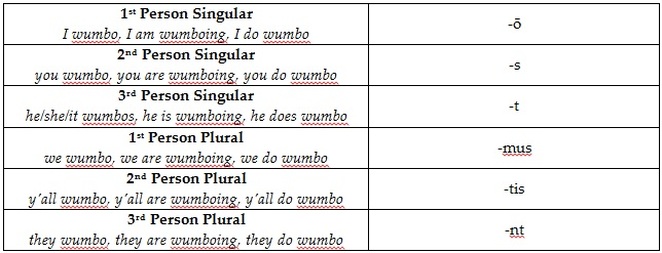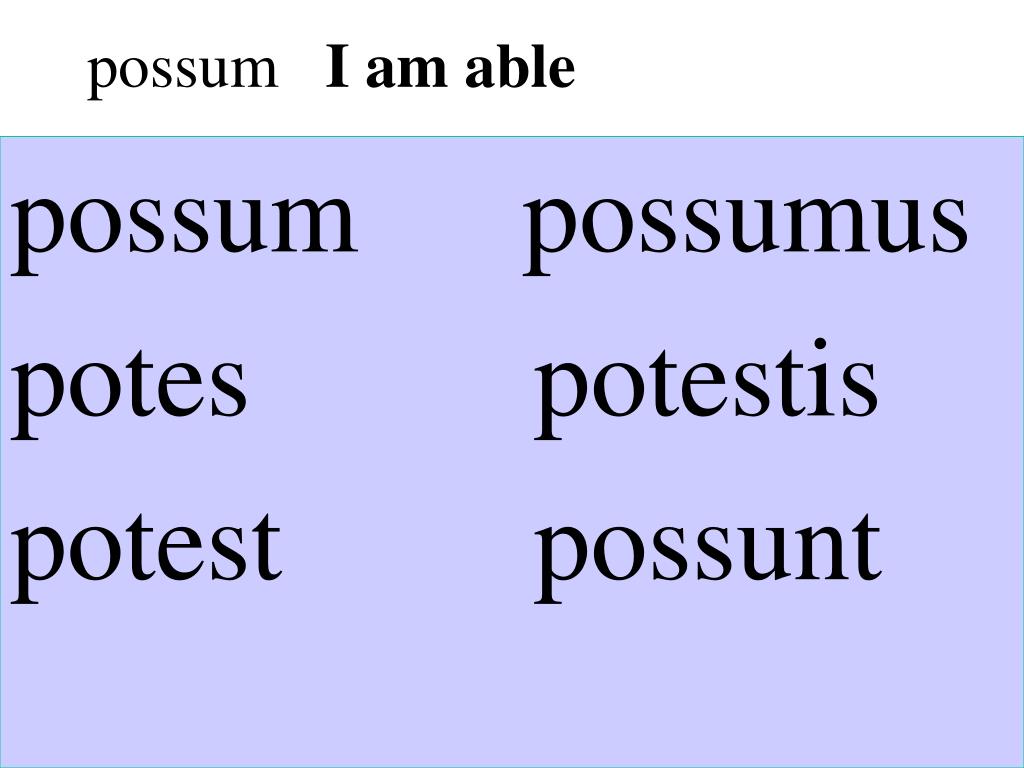


Thus 1st conjugation verbs in the first three persons singular end in -ō, -ās, -at, 2nd conjugation in -eō, -ēs, -et, 3rd conjugation -ō, -is, -it (or -iō, -is, -it), and 4th conjugation in -iō, -īs, -it. The present tense of regular verbs is formed in different ways according to the conjugation of the verb. Some perfect and pluperfect tenses can be shortened by omitting v: amāram, amāssem, audierat for amāveram, amāvissem, audīverat. Some verbs (namely 1st and 2nd conjugation verbs and the verb eō 'I go') have a future tense ending in -bō, -bis, -bit instead of -am, -ēs, -et, for example amābō 'I will love', vidēbō 'I will see', ībō 'I will go'. The present subjunctive and future indicative in dūcō and other 3rd and 4th conjugation verbs are identical in the 1st person, but are different in the other persons: the present subjunctive has dūcam, dūcās, dūcat etc, while the future has dūcam, dūcēs, dūcet. Infectum passive and deponent tenses (3rd conjugation) Infectum tenses Overview Infectum active tenses (3rd conjugation and sum) 7.5 Indirect commands with the infinitive.6.5 Exceptions to the sequence of tenses rule.5.2.4 Periphrastic pluperfect subjunctive.5.2.2 Periphrastic imperfect subjunctive.3.2.7 Subordinate clauses in indirect speech.3.1.4.4 Conditional clauses of comparison.3.1.4.2 Ideal or future conditional in a past context.2.7.5 Pluperfect subjunctive with fuissem.2.7.4 Pluperfect indicative with fueram.2.7 Perfect passive tenses made with fuī and fueram.2.6 Perfect passive and deponent tenses.2.4.2 Iterative use in temporal clauses.2.2.5 Iterative action in a temporal or relative clause.1.2.6 Present with perfect continuous meaning.The infinitive has two main tenses (present and perfect) as well as a number of periphrastic tenses used in reported speech. Participles in Latin have three tenses (present, perfect, and future) and the imperative mood has two tenses (present and future). In addition to these six tenses of the indicative mood, there are four tenses in the subjunctive mood: present, imperfect, perfect, and pluperfect ( faciam, facerem, fēcerim, fēcissem). In some cases Latin makes a distinction which is not made in English: for example, imperfect eram and perfect fuī both mean 'I was' in English, but they differ in Latin. Latin tenses do not have exact English equivalents, so that often the same tense can be translated in different ways depending on its context: for example, faciō can be translated as 'I do', 'I am doing' or 'I did', and fēcī can be translated as 'I did' and 'I have done'. To these six main tenses can be added various periphrastic tenses, such as factūrus sum 'I am going to do'.

For example, from the verb faciō 'I do' the three non-perfect tenses are faciō, faciam, faciēbam 'I do, I will do, I was doing', made with the stem faci-, and the three perfect tenses are fēcī, fēcerō, fēceram 'I did, I will have done, I had done', made with the stem fēc. The two sets of tenses are made using different stems. In technical language, the first three tenses are known as the īnfectum tenses, while the three perfect tenses are known as perfectum.

Latin has six main tenses: three non-perfect tenses (the present, future, and imperfect) and three perfect tenses (the perfect, future perfect, and pluperfect). For the formation of the tenses, see Latin conjugation.


 0 kommentar(er)
0 kommentar(er)
